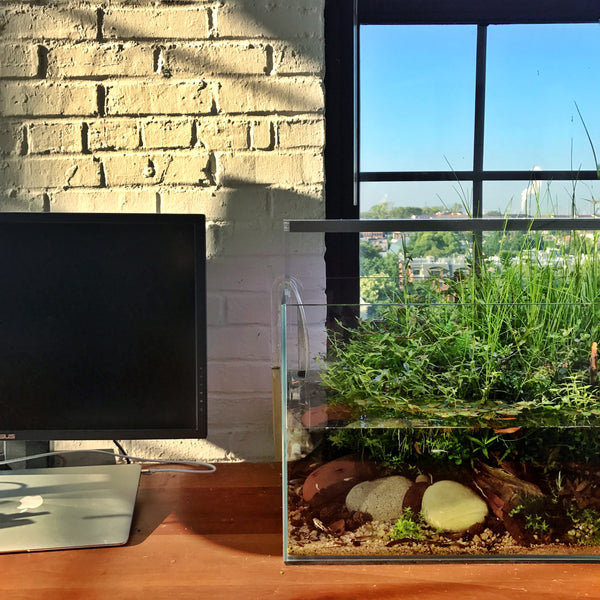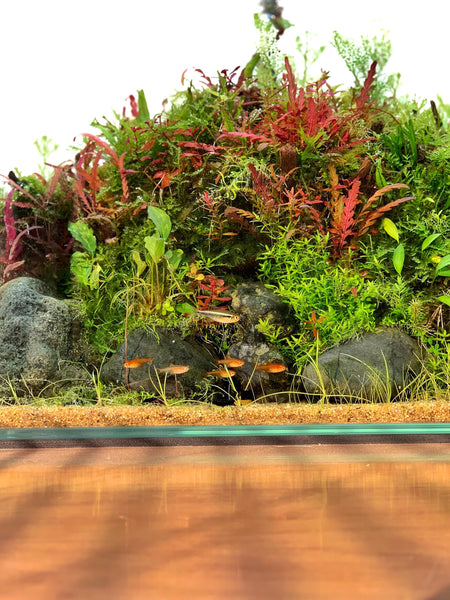
How to Keep an Aquarium Next to a Window Algae Free!
Sometimes the perfect space for an aquarium is near a window, or in a bright, sunny spot. Unfortunately, the idea that sunlight causes algae, scares many hobbyists into keeping their tanks in darkened rooms. In reality, it is perfectly possible, even preferable, to keep your tank in a bright, cheery, sun-filled environment, with no algae problems. All you have to do is avoid three common pitfalls that can lead to trouble. Here is a quick guide to keeping your aquarium bright and clean, even if it is situated right next to a window.
As I tell people all the time, the root of all algae problems is the presence of excessive nutrients in a tank, beyond what plants can utilize. Most commonly, the culprit is excess phosphates and/or nitrogenous wastes. These ingredients are common in industrial and aquarium fertilizer, which is why fertilizer runoff from agriculture is well known to cause algae blooms in ponds and even oceans. When this runoff causes environmental algae problems, does anyone suggest that the sun being too bright is what caused the algae bloom? Of course not, and why should an aquarium be any different? While algae require light to grow, and will indeed grow more vigorously under sustained bright light, the presence of excess nutrients is a requirement for this to occur.
Thus, pitfall number one: adding too much fertilizer (especially in the early stages of a tank’s lifespan) and/or overstocking a tank. If you can avoid these common errors and keep up a steady routine of water changes, you can typically avoid excess nutrients, and thus excess algae, especially as the tank matures. Much like society asks farmers to control their fertilizer runoff to prevent algae blooms, we should ask ourselves to avoid adding too much fertilizer (or fish food, or fish waste) to our tanks.
A second, common pitfall: starting a new tank with a very small plant mass. True plants will always outcompete algae if they are present in sufficient quantities to consume environmental nutrients. Even if you are not dosing fertilizer, enriched substrate, fish, and decaying organic material can still leach nutrients into a tank. Tap water itself can contain dissolved phosphates and sediments that can contribute to algae growth. Thus, if you start a tank out in a bright room, you are at a serious disadvantage if you are not planting it heavily prior to adding water. I sometimes see beginners create a rock-heavy scape with very few plants, situated in a sunny room; this is not a good idea. Do not skimp on plants in the hope that they will ‘fill in.’
The last, most serious pitfall: very prolonged direct sunlight can theoretically cause a tank to overheat. This tends to be a problem in rooms that are already very hot (perhaps not air-conditioned), and even then this only tends to occur when the tank receives sustained, direct sunlight for many hours at a time. Because the sun moves throughout the day, it is highly unlikely for this perfect storm to occur, unless the tank is located in a greenhouse or solarium with a glass roof. A few daily hours of direct sunlight will not be enough to push your tank over the edge unless the ambient temperature in the room (or aquarium heater setting) is already borderline. With this said, it is a good idea to monitor the temperature of a new tank. You could even test this prior to set up by measuring the temperature in a jug of water where the aquarium will be situated. In my experience, this has never been an issue. If you have never felt particularly scorched when hanging out in the location where you intend to place your tank, I doubt it will be an issue for you either.
Most plants and people enjoy a little sunshine, and planted tanks look their best when photographed in a bright, sunny room. The next time someone tries to scare you away from setting up a tank in a bright room, keep these tips in mind- there’s no need to deprive yourself!
Tell us - Was this article helpful? Please leave a comment below!
If you have any questions regarding this article, please DM us on Instagram, Facebook, or email support@buceplant.com so we can assist you - @buceplant








Comments
Leave a comment